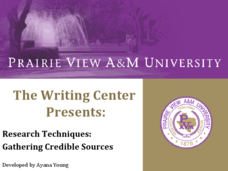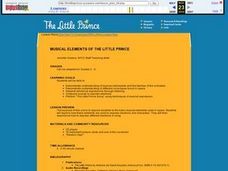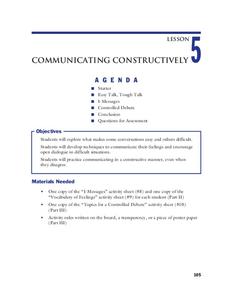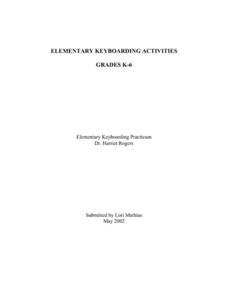Curated OER
Dinosaurs - Real and Make Believe
Students examine the differences between real and make believe dinosaurs, and identify survival techniques utilized by dinosaurs. They create dioramas illustrating dinosaurs using survival techniques.
Curated OER
Research Techniques: Gathering Credible Sources
How can you spot a credible source? What even makes a resource reliable in the first place? Answer some of these questions with this presentation. Although intended for higher education, this PowerPoint could be modified for middle...
Curated OER
Developing Reading Comprehension
Developing reading comprehension is an ongoing process that begins the moment a child becomes engaged with literature. From learning the skills to navigate a picture book to reading an assigned chapter in a chemistry text, good readers...
Curated OER
MUSICAL ELEMENTS OF THE LITTLE PRINCE
Students demonstrate knowledge of musical instruments and the families of the orchestra. They acknowledge different voice types found in opera. Students interpret emotional expressions through listening. They compose sounds to express...
Curated OER
Expository Journal Prompts
Stuck for a journal topic? Download CAHSEE’s 21 “Expository Journal Prompts” as a pdf handout for yourself or class. A great resource for your writing program, print it up and add it your curriculum library.
Curated OER
The BEAM Project: Building Efficient Architectural Models
Technology or engineering teams are given a task to design, construct, and test the efficiency of a structure that will foster an even temperature throughout an entire sunny day. Intended as a long-term project, pupils research, plan,...
Curated OER
Using Creative Techniques to Get Students to Read
You can get students to enjoy reading if you allow them to be more involved in the book selection process.
Curated OER
Snowflake Bentley
Learners explore crystals through the story Snowflake Bentley and then create crystal pictures of their own. In this interdisciplinary lesson, they create a crystal web chart on chart paper, design artificial snowflakes, and write poems...
Curated OER
Edward Lear, Limericks, and Nonsense: There Once Was...
Young scholars recognize poetic devices including rhyme, syllabification, and meter. They identify the characteristics of a nonsense poem and of a limerick. They write their own limericks.
Curated OER
Haiku
Fourth graders create a haiku. They use a digial camera and file management techniques to save work. They also use a photo editor to manipulate the pictures. Finally, they create a PowerPoint presentation of their Haiku.
Curated OER
Genre Study
Third graders develop an understanding of genre by participating in small- and whole-group activities. In addition, they practice presentation and specific listening skills. This lesson plan assumes students have been regularly exposed...
Pennsylvania Department of Education
6 Traits: Word Choice
Students explore language arts by participating in a vocabulary usage activity. In this word choice lesson, students read examples of great word usage in literature and discuss with the class why some words appear stronger than others....
Curated OER
Water Cycle - A SiteMaker Presentation
Have your young scientists explore a single element of the water cycle and write a report to explain findings. Your class can take their writing through all the steps of the writing process and publish it using a Web-based multimedia...
Curated OER
Figurative Language
What is figurative language, and why do we use it? Introduce your high schoolers to some examples and discuss the importance of including this element in your writing. After studying a text and searching for examples, writers will...
Curated OER
Accurately Weighing Pennies II
Drawing from a scenario of the history of the penny, learners write and solve a system of linear equations from a context.
Overcoming Obstacles
Communicating Constructively
Some types of verbal communication are just more difficult that others. High schoolers engage in a series of activities that are designed to help teens make difficult conversations easier and more effective.
Curated OER
For the Birds
Second graders observe, identify, and document birds sighted at the library feeder station. They observe and document birds in order to begin their birder's life list. They apply scientific concepts and principles by using library...
Curated OER
Elementary Keyboarding Activities
Listen to the sound of children's fingers flying across their keyboards as they perform these fun typing lessons. From creating alphabet books and multimedia presentations to researching presidents and writing class newsletters, numerous...
Shutterfly
Shutterfly Photo Story Lesson Plan
A reading of Peggy Parish's Amelia Bedelia launches a study of idioms. Groups then select several idioms, write the meaning of the expressions, draw or select images, and use GIMP or Photoshop to create an idiom book.
Curated OER
Teaching With Documents Lesson Plan: "A Date Which Will Live in Infamy"
Your class examines F.D.R.'s speech for examples of repetition, alliteration, emotionally charged words, etc. They listen to the speech and interview a person who heard it delivered. They finish by writing an article about the experience.
Curated OER
Giants of the Century
Middle and high schoolers study significant people who shaped the 20th-century history and are introduced to database tools. Researchers use the Internet to research five 20th century history makers. They write a short biography of five...
Curated OER
Tangerine: Vocabulary
Here's a great way to make vocabulary words drawn from Edward Bloor's novel Tangerine memorable. Kids create a word square, and in one quadrant write the word. A picture goes in a second quadrant, the definition in a third, and a...
Curated OER
Analyzing the Use of Irony in a Short Story
Ninth graders examine how literature connects to real-life and see how irony aids in the development of theme. They read Shirley Jackson's The Lottery, and discuss elements of foreshadowing and situational irony. Then learners will write...
Curated OER
Fluency Activities for Lower Levels
Readers participate in activities designed to increase their fluency with language. They collaborate in small groups to complete stem sentences about themselves. They write facts about themselves and answer questions asked by the other...

























